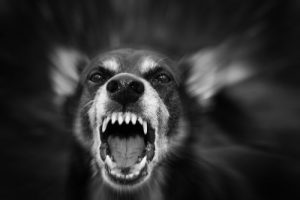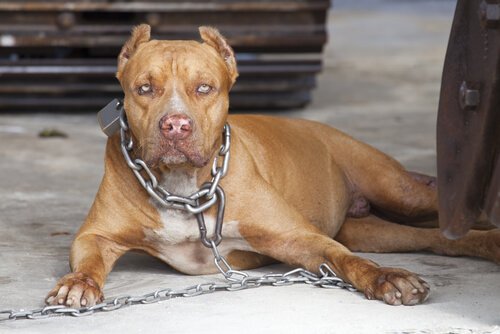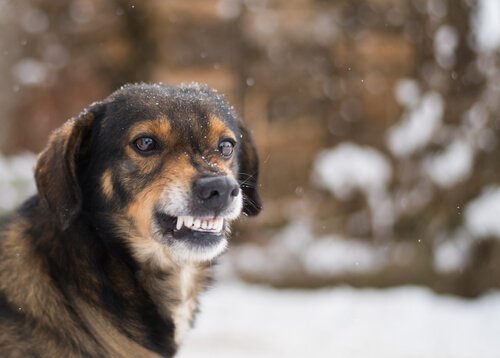Reasons Why a Dog May Become Aggressive

Aggression in dogs is a problem that everyone is afraid of. Whether small or large, an aggressive dog is unpredictable and, in many cases, dangerous. These are some of the most common reasons that a dog may become aggressive.
Why a dog may become aggressive
Understanding the reasons why a dog may become aggressive is essential in figuring out how to treat and correct this behavioral problem. This type of information from canine trainers and ethologists would be great for families.
However, the treatment for aggressive behavior should be designed and carried out by a professional. This behavior is dangerous for both the dog and humans, so it’s important to find a positive trainer.
The problem is that not treating or not treating the aggression can make the behavioral problem even worse. So, the animal’s coexistence with the family becomes even more difficult, and someone may end up getting hurt.
Fear
Fear is one of the main reasons that a dog may become aggressive. Usually, the dog is exposed to something — which they can’t get away from – that scares them on a daily basis. So, you may be able to help their aggression if you notice that your pet is fearful of something.

For example, aggressiveness is common in dogs that chase after to bikes or skateboards. The noise and movement scare them and, if they bark or run after them, they believe they’re making it disappear. The best thing you can do is give them a light tug on the leash and get them away from the situation.
The first thing to do when starting to treat your dog’s aggression is to avoid anything that scares them. Keeping your dog exposed to the problem will only worsen their aggression. Changing your walking route, or the hours that you take him out for a walk, will help you avoid the thing that scares them, and this will help to stop their aggressive reactions and improve their quality of life.
Tugging on the leash
A dog’s aggressive reaction can often be linked to the way that their owner manages the leash. Many of the interactions that dogs have with other dogs result in one, or both, of them, feeling a tug on their neck, which may cause them to act more aggressively.
Leashes are a strong element of communication. Calmness, hastiness or worrying can all be communicated through the use of a leash. Any sudden movement you make on your end of the leash affects your pet, usually in the sensitive area of their neck. Sometimes you use the leash aggressively, without even realizing it.
Also, there are certain types of collars that cause problems with dogs. Spiked collars, for example, are painful for animals. If metallic pins stick into your dog’s neck every time a bike or child passes by, they will try to get away from the pain before they feel it.

This relationship is one of the basic laws of learning about classical conditioning formulated by Pavlov. To treat this, it’s important to get rid of any kind of collar that is painful, and to stop pulling on your pet’s leash so much.
Protecting resources
Dogs show aggression when they’re protecting something that they consider valuable or important. Dogs that show their teeth or growl while they’re eating usually do that to protect their food.
However, it doesn’t just happen with food. Their bed, toys, and even their family can be things that trigger these aggressive reactions.
To start dealing with these problems, the dog should understand that he doesn’t have to protect his food or bed and he won’t be interrupted while he’s sleeping and he’ll always have enough food in his bowl. Trust is very important when correcting this problem. However, as with the other cases in this article, it’s necessary to have the help of a professional trainer.
Pain or disease
A dog’s aggressiveness may be an attempt to cover up pain or discomfort: they don’t want to have contact with humans or other animals so they won’t touch their wound areas. There are also cases of hormonal imbalances whose symptoms are aggressive or exaggerated reactions.

So, if a dog becomes aggressive, or has a radical behavioral change in a short period of time, it’s important to visit your vet to rule out any physical causes. Also, once they have reached seven years of age, they may start to suffer from joint pain or hip dysplasia.
Only a vet can diagnose a physical cause for aggression and propose a treatment to help make this pain disappear. A trainer can help restore your pet’s confidence so that those exaggerated reactions will disappear, but a vet will solve any health issues.
Aggression in dogs is a problem that worries everyone. Each dog has a different reason and, without knowing that reason, you can’t start treatment to correct the problem. Contact a trainer or veterinarian to get your pet’s behavior back to normal.
Aggression in dogs is a problem that everyone is afraid of. Whether small or large, an aggressive dog is unpredictable and, in many cases, dangerous. These are some of the most common reasons that a dog may become aggressive.
Why a dog may become aggressive
Understanding the reasons why a dog may become aggressive is essential in figuring out how to treat and correct this behavioral problem. This type of information from canine trainers and ethologists would be great for families.
However, the treatment for aggressive behavior should be designed and carried out by a professional. This behavior is dangerous for both the dog and humans, so it’s important to find a positive trainer.
The problem is that not treating or not treating the aggression can make the behavioral problem even worse. So, the animal’s coexistence with the family becomes even more difficult, and someone may end up getting hurt.
Fear
Fear is one of the main reasons that a dog may become aggressive. Usually, the dog is exposed to something — which they can’t get away from – that scares them on a daily basis. So, you may be able to help their aggression if you notice that your pet is fearful of something.

For example, aggressiveness is common in dogs that chase after to bikes or skateboards. The noise and movement scare them and, if they bark or run after them, they believe they’re making it disappear. The best thing you can do is give them a light tug on the leash and get them away from the situation.
The first thing to do when starting to treat your dog’s aggression is to avoid anything that scares them. Keeping your dog exposed to the problem will only worsen their aggression. Changing your walking route, or the hours that you take him out for a walk, will help you avoid the thing that scares them, and this will help to stop their aggressive reactions and improve their quality of life.
Tugging on the leash
A dog’s aggressive reaction can often be linked to the way that their owner manages the leash. Many of the interactions that dogs have with other dogs result in one, or both, of them, feeling a tug on their neck, which may cause them to act more aggressively.
Leashes are a strong element of communication. Calmness, hastiness or worrying can all be communicated through the use of a leash. Any sudden movement you make on your end of the leash affects your pet, usually in the sensitive area of their neck. Sometimes you use the leash aggressively, without even realizing it.
Also, there are certain types of collars that cause problems with dogs. Spiked collars, for example, are painful for animals. If metallic pins stick into your dog’s neck every time a bike or child passes by, they will try to get away from the pain before they feel it.

This relationship is one of the basic laws of learning about classical conditioning formulated by Pavlov. To treat this, it’s important to get rid of any kind of collar that is painful, and to stop pulling on your pet’s leash so much.
Protecting resources
Dogs show aggression when they’re protecting something that they consider valuable or important. Dogs that show their teeth or growl while they’re eating usually do that to protect their food.
However, it doesn’t just happen with food. Their bed, toys, and even their family can be things that trigger these aggressive reactions.
To start dealing with these problems, the dog should understand that he doesn’t have to protect his food or bed and he won’t be interrupted while he’s sleeping and he’ll always have enough food in his bowl. Trust is very important when correcting this problem. However, as with the other cases in this article, it’s necessary to have the help of a professional trainer.
Pain or disease
A dog’s aggressiveness may be an attempt to cover up pain or discomfort: they don’t want to have contact with humans or other animals so they won’t touch their wound areas. There are also cases of hormonal imbalances whose symptoms are aggressive or exaggerated reactions.

So, if a dog becomes aggressive, or has a radical behavioral change in a short period of time, it’s important to visit your vet to rule out any physical causes. Also, once they have reached seven years of age, they may start to suffer from joint pain or hip dysplasia.
Only a vet can diagnose a physical cause for aggression and propose a treatment to help make this pain disappear. A trainer can help restore your pet’s confidence so that those exaggerated reactions will disappear, but a vet will solve any health issues.
Aggression in dogs is a problem that worries everyone. Each dog has a different reason and, without knowing that reason, you can’t start treatment to correct the problem. Contact a trainer or veterinarian to get your pet’s behavior back to normal.
This text is provided for informational purposes only and does not replace consultation with a professional. If in doubt, consult your specialist.








